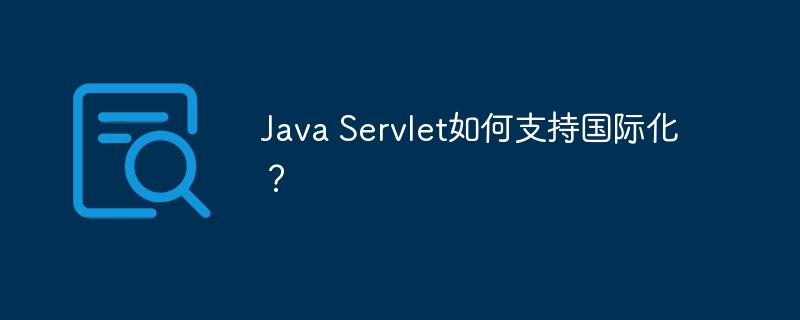How does Java Servlet support internationalization?
在 Java Servlet 中,国际化通过使用国际化资源束和 Locale 类实现,具体步骤如下:创建国际化资源束(.properties 文件),分别存储不同语言(_语言代码)和国家(_国家代码)的翻译文本。使用 Locale 类获取当前语言环境设置。通过 ResourceBundle.getBundle 加载正确的资源束。使用 bundle.getString 获取对应键的翻译文本。通过 Locale.setDefault 设置默认语言环境。使用 request.getLocale 获取请求的语言环境。使用 EL 表达式在视图中显示翻译文本。

如何在 Java Servlet 中支持国际化
简介
国际化是使应用程序支持多种语言和文化的过程。在 Java Servlet 中,国际化通过使用国际化资源束和 Locale 类来实现。
国际化资源束
国际化资源束是一组翻译好的字符串,用于不同语言的文本。它们以 .properties 文件的形式存储,文件名遵循以下格式:[基本文件名]_[语言代码]_[国家代码].properties。例如,一个包含英文文本的资源束可以命名为 messages_en_GB.properties。
创建资源束
要创建一个资源束,请按照以下步骤操作:
- 创建一个
.properties文件。 - 使用以下语法为每个字符串添加键值对:
KEY=VALUE
- 为不同的语言和国家创建额外的资源束,使用适当的文件名。
实例
下面是一个包含英语和西班牙语文本的资源束示例:
// messages_en_GB.properties welcome=Welcome username=Username // messages_es_ES.properties welcome=Bienvenido username=Nombre de usuario
使用 Locale 类
Locale 类表示特定语言和国家的设置。它用于从资源束中获取正确翻译的字符串。
读取资源束
要读取资源束,请使用以下代码:
ResourceBundle bundle = ResourceBundle.getBundle("messages", Locale.getDefault());这将加载与当前 Locale 匹配的资源束。
获取翻译的字符串
要获取翻译的字符串,请使用以下代码:
String welcomeText = bundle.getString("welcome");这将检索与指定键对应的翻译的字符串。
实战案例
1. Servlet 初始化
在 Servlet 初始化方法中,我们可以设置默认 Locale:
@Override
public void init() {
Locale defaultLocale = Locale.getDefault();
Locale.setDefault(defaultLocale);
}2. 响应请求
在响应请求时,我们可以根据请求的 Locale 获取翻译的字符串:
@Override
protected void doGet(HttpServletRequest request, HttpServletResponse response) {
ResourceBundle bundle = ResourceBundle.getBundle("messages", request.getLocale());
request.setAttribute("welcomeText", bundle.getString("welcome"));
}3. 显示视图
在 JSP 视图中,我们可以使用 EL 表达式显示翻译的字符串:
<h1>${welcomeText}</h1>这将在不同的语言中显示“欢迎”文本。
The above is the detailed content of How does Java Servlet support internationalization?. For more information, please follow other related articles on the PHP Chinese website!

Hot AI Tools

Undresser.AI Undress
AI-powered app for creating realistic nude photos

AI Clothes Remover
Online AI tool for removing clothes from photos.

Undress AI Tool
Undress images for free

Clothoff.io
AI clothes remover

AI Hentai Generator
Generate AI Hentai for free.

Hot Article

Hot Tools

Notepad++7.3.1
Easy-to-use and free code editor

SublimeText3 Chinese version
Chinese version, very easy to use

Zend Studio 13.0.1
Powerful PHP integrated development environment

Dreamweaver CS6
Visual web development tools

SublimeText3 Mac version
God-level code editing software (SublimeText3)

Hot Topics
 Perfect Number in Java
Aug 30, 2024 pm 04:28 PM
Perfect Number in Java
Aug 30, 2024 pm 04:28 PM
Guide to Perfect Number in Java. Here we discuss the Definition, How to check Perfect number in Java?, examples with code implementation.
 Weka in Java
Aug 30, 2024 pm 04:28 PM
Weka in Java
Aug 30, 2024 pm 04:28 PM
Guide to Weka in Java. Here we discuss the Introduction, how to use weka java, the type of platform, and advantages with examples.
 Smith Number in Java
Aug 30, 2024 pm 04:28 PM
Smith Number in Java
Aug 30, 2024 pm 04:28 PM
Guide to Smith Number in Java. Here we discuss the Definition, How to check smith number in Java? example with code implementation.
 Java Spring Interview Questions
Aug 30, 2024 pm 04:29 PM
Java Spring Interview Questions
Aug 30, 2024 pm 04:29 PM
In this article, we have kept the most asked Java Spring Interview Questions with their detailed answers. So that you can crack the interview.
 Break or return from Java 8 stream forEach?
Feb 07, 2025 pm 12:09 PM
Break or return from Java 8 stream forEach?
Feb 07, 2025 pm 12:09 PM
Java 8 introduces the Stream API, providing a powerful and expressive way to process data collections. However, a common question when using Stream is: How to break or return from a forEach operation? Traditional loops allow for early interruption or return, but Stream's forEach method does not directly support this method. This article will explain the reasons and explore alternative methods for implementing premature termination in Stream processing systems. Further reading: Java Stream API improvements Understand Stream forEach The forEach method is a terminal operation that performs one operation on each element in the Stream. Its design intention is
 Create the Future: Java Programming for Absolute Beginners
Oct 13, 2024 pm 01:32 PM
Create the Future: Java Programming for Absolute Beginners
Oct 13, 2024 pm 01:32 PM
Java is a popular programming language that can be learned by both beginners and experienced developers. This tutorial starts with basic concepts and progresses through advanced topics. After installing the Java Development Kit, you can practice programming by creating a simple "Hello, World!" program. After you understand the code, use the command prompt to compile and run the program, and "Hello, World!" will be output on the console. Learning Java starts your programming journey, and as your mastery deepens, you can create more complex applications.
 Java Made Simple: A Beginner's Guide to Programming Power
Oct 11, 2024 pm 06:30 PM
Java Made Simple: A Beginner's Guide to Programming Power
Oct 11, 2024 pm 06:30 PM
Java Made Simple: A Beginner's Guide to Programming Power Introduction Java is a powerful programming language used in everything from mobile applications to enterprise-level systems. For beginners, Java's syntax is simple and easy to understand, making it an ideal choice for learning programming. Basic Syntax Java uses a class-based object-oriented programming paradigm. Classes are templates that organize related data and behavior together. Here is a simple Java class example: publicclassPerson{privateStringname;privateintage;
 Java Program to Find the Volume of Capsule
Feb 07, 2025 am 11:37 AM
Java Program to Find the Volume of Capsule
Feb 07, 2025 am 11:37 AM
Capsules are three-dimensional geometric figures, composed of a cylinder and a hemisphere at both ends. The volume of the capsule can be calculated by adding the volume of the cylinder and the volume of the hemisphere at both ends. This tutorial will discuss how to calculate the volume of a given capsule in Java using different methods. Capsule volume formula The formula for capsule volume is as follows: Capsule volume = Cylindrical volume Volume Two hemisphere volume in, r: The radius of the hemisphere. h: The height of the cylinder (excluding the hemisphere). Example 1 enter Radius = 5 units Height = 10 units Output Volume = 1570.8 cubic units explain Calculate volume using formula: Volume = π × r2 × h (4






